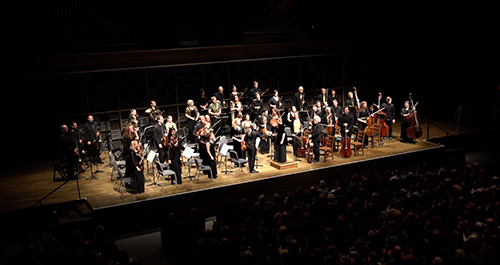by Timothy Robson

The program opened with the overture to Mozart’s opera buffa La finta semplice (“The Fake Innocent”), written in 1768 when he was 12 years old. The opera itself is seldom performed, but the charming overture in three sections is heard occasionally in concert. Composed only a dozen years after the death of J.S. Bach, it seems a natural for Apollo’s Fire. The primary sonic innovations are the more prominent use of horns, flutes, oboes, and bassoons.
After an opening Allegro, a slower middle section features huge melodic leaps in the strings from low-to-high register. The third section is a tarantella, that perpetual motion Italian dance. Apollo’s Fire played the overture with charm and sparkling precision.
Mozart’s Symphony No. 40 is one of the pillars of Classical-era orchestral repertoire, and in taking it on, Apollo’s Fire set itself up for inevitable comparison with countless other live and recorded readings. The ensemble played with a delicacy and unity of sound unmatched by modern-instrument orchestras, even when reduced to chamber-size. But, especially in the first movement, the phrasing of the main theme’s upward leaps seemed overemphasized and self-conscious.
Similar over-phrasing affected the Andante, although the later drama of the movement increased tension and included beautifully-played duets between flute and oboe. The short-long rhythms were exacting and helped build to a dramatic grand pause before the closing repetition of earlier music.
The Menuetto was rustic and sharply accented, while the Trio was gracious and naturally phrased. The remarkably precise final movement emphasized dynamic contrasts highlighted by beautiful wind solos. Here Apollo’s Fire showed its musical excellence most effectively.
Haydn was represented by the opening Allegro from his Concertante in B-flat, Hob. I/105. The outstanding soloists were Susanna Perry Gilmore, violin, Debra Nagy, oboe, Stephanie Corbin, bassoon, and Ezra Seltzer, cello. The solo parts were virtuosic, and Sorrell managed the balances well between soloists and orchestra. Although relatively brief, this was for me the highlight of the concert, showing the musicians of Apollo’s Fire musicians at their best.
The concert ended with a five-movement suite of “Baroque” dances from Mozart’s Idomeneo, written in 1781 and first performed in Munich. Full of da capo arias, opera seria (“serious opera”) dominated Italian opera from the 1710s through the 1770s, and Mozart’s example is one of the last masterpieces in the genre. The plots are complex and usually strain credulity with their sudden, magical endings. In the heroic finale of Idomeneo, the hero Idamante thrillingly kills a sea monster, prompting twenty or so minutes of ballet music.
Jeannette Sorrell characterized the suite as “Mozart with a Baroque accent,” and here Apollo’s Fire was in familiar territory. Despite French titles (Chaconne, Passepied, Gavotte, etc.) the music is thoroughly Germanic. The movements are full of impressive majesty and virtuosic writing that was impressively played on Friday evening. My reservations about phrasing earlier in the program melted away.
Photo by Erica Brenner Productions from an earlier Apollo’s Fire concert in Gartner Auditorium.
Published on ClevelandClassical.com October 16., 2018.
Click here for a printable copy of this article



